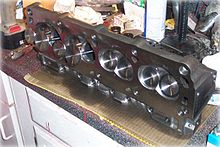- Cylinder head
-
In an internal combustion engine, the cylinder head (often informally abbreviated to just head) sits above the cylinders on top of the cylinder block. It closes in the top of the cylinder, forming the combustion chamber. This joint is sealed by a head gasket. In most engines, the head also provides space for the passages that feed air and fuel to the cylinder, and that allow the exhaust to escape. The head can also be a place to mount the valves, spark plugs, and fuel injectors.
In a flathead or sidevalve engine, the mechanical parts of the valve train are all contained within the block, and the head is essentially a metal plate bolted to the top of the block; this simplification avoids the use of moving parts in the head and eases manufacture and repair, and accounts for the flathead engine's early success in production automobiles and continued success in small engines, such as lawnmowers. This design, however, requires the incoming air to flow through a convoluted path, which limits the ability of the engine to perform at higher revolutions per minute (rpm), leading to the adoption of the overhead valve (OHV) head design, and the subsequent overhead camshaft (OHC) design.
Contents
Detail
Internally, the cylinder head has passages called ports or tracts for the fuel/air mixture to travel to the inlet valves from the intake manifold, for exhaust gasses to travel from the exhaust valves to the exhaust manifold. In a water-cooled engine, the cylinder head also contains integral ducts and passages for the engines' coolant - usually a mixture of water and antifreeze - to facilitate the transfer of excess heat away from the head, and therefore the engine in general.
In the overhead valve (OHV) design, the cylinder head contains the poppet valves and the spark plugs, along with tracts or 'ports' for the inlet and exhaust gases. The operation of the valves is initiated by the engine's camshaft, which is sited within the cylinder block, and its moment of operation is transmitted to the valves pushrods, and then rocker arms mounted on a rocker shaft - the rocker arms and shaft also being located within the cylinder head.
In the OHC design, the cylinder head contains the valves, spark plugs and inlet/exhaust tracts just like the OHV engine, but the camshaft is now also contained within the cylinder head. The camshaft may be seated centrally between each offset row of inlet and exhaust valves, and still also utilizing rocker arms (but without any pushrods), or the camshaft may be seated directly above the valves eliminating the rocker arms and utilizing 'bucket' tapets.
Implementation
The number of cylinder heads in an engine is a function of the engine configuration. Almost all inline (straight) engines today use a single cylinder head that serves all the cylinders. A V (or Vee) engine has two cylinder heads, one for each cylinder bank of the 'V'. For a few compact 'narrow angle' V engines, such as the Volkswagen VR6, the angle between the cylinder banks is so narrow that it uses a single head spanning the two banks. A flat engine (basically a V engine, where the angle between the cylinder banks is now 180°) has two heads. Most radial engines have one head for each cylinder, although this is usually of the monobloc form wherein the head is made as an integral part of the cylinder.
Some engines, particularly medium- and large-capacity diesel engines built for industrial, marine, power generation, and heavy traction purposes (large trucks, locomotives, heavy equipment etc.) have individual cylinder heads for each cylinder. This reduces repair costs as a single failed head on a single cylinder can be changed instead of a larger, much more expensive unit fitting all the cylinders. Such a design also allows engine manufacturers to easily produce a 'family' of engines of different layouts and/or cylinder numbers without requiring new cylinder head designs.
The design of the cylinder head is key to the performance and efficiency of the internal combustion engine, as the shape of the combustion chamber, inlet passages and ports (and to a lesser extent the exhaust) determines a major portion of the volumetric efficiency and compression ratio of the engine.
Gallery
-
A single overhead camshaft (SOHC) cylinder head from a Honda D15A3.
-
A double overhead camshaft (DOHC) cylinder head from a Honda K20Z3.
-
Overhead view of an air cooled cylinder head from a Suzuki GS550 showing dual camshafts, drive sprockets and cooling fins.
See also
- Junk head
- Monobloc engine
References
External links
- Assembly of Ford 3d Duratec HE Engine - video showing construction and operation of four cylinder internal combustion engine courtesy of Ford Motor Company
Categories:- Cylinder head
- Engine technology
Wikimedia Foundation. 2010.







